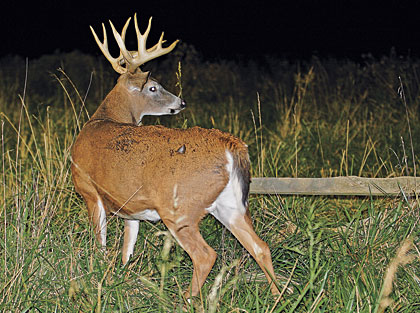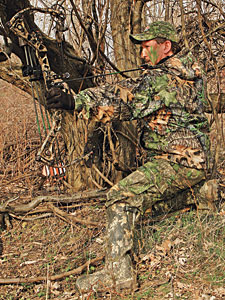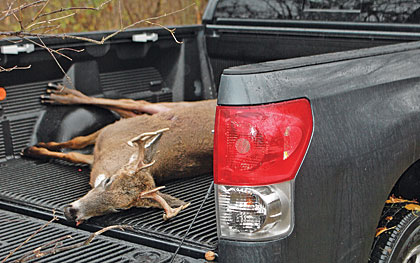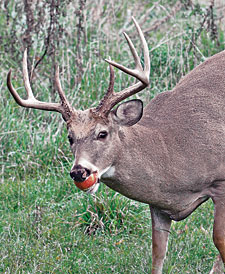December 10, 2010
By Bill Vanzis
Five Prime Ambush Positions for Tagging Backwoods Bruisers.
By Bill Vanzis
 Wilderness bucks sometimes leave the cover of the big woods to feed in nearby abandoned farmland. However, they will usually do so under the cover of darkness. |
He appeared out of nowhere, with his nose to the ground like a beagle dogging a bunny. I quickly pulled an arrow from my quiver and dropped to one knee next to a stump. I had not seen a deer -- much less a buck -- in nearly a week, and this one was almost on top of me. I knew the tall-tined 8-pointer was about to pass broadside to me, and when he disappeared behind a blow down, I brought my bow to full draw and waited for a clear opening. Suddenly, he stepped from behind the fallen tree, but before I could settle my pin he moved into a patch of head high goldenrod growing along the inside edge of the clear-cut.
I pivoted my torso and stayed with the buck until he once again stepped into an opening 25 yards distant and stood, quartering away from me. I picked a spot near the last rib on his left side, held my pin there for a second and released. The broadhead hit with a resounding WHACK, and the buck took off across the old clear-cut like a scalded dog. I found him piled up 100 yards away, his mahogany rack glistening in the early-morning sun just a few yards from the edge of the cut.
Advertisement
Bowhunting wilderness bucks can seem like an overwhelming task. The terrain is often foreboding, the vegetation impenetrable and the bucks few and far between. That's the bad news. The good news is you don't need written permission to bowhunt most big woods areas. In fact, you usually have the woods all to yourself. In some areas, the bucks generally grow old and die without ever getting a whiff of a stinky human.
Advertisement
Most trophy bucks are arrowed in and around rural farming areas, but according to my analysis of all the various record books, there are plenty of trophy bucks available in the big woods for hardcore bowhunters. Why? There are so few hunters afield there that bucks are more likely to live into their third, fourth, fifth or even eighth years, as evidenced by statistics from various wilderness deer check stations. With good mast crops and an easy winter or two, these mature, heavyweight bucks can grow prodigious racks that compare favorably to their farmland cousins!
Here are five prime ambush spots to get yourself a shot at a wilderness monarch:
 Narrow strips of standing cover between thick, regenerating clear-cut areas can be prime areas to sneak up on big-woods bucks that use these areas as travel corridors. That's exactly what the author was doing when he took the buck described at the beginning of this article. |
Steep Ravines
Sometimes you can locate a natural ambush site simply by looking at a topographic map. Ravines, especially those that originate in hilly country, are one of my favorites. These big ditches, caused by hundreds of years of seasonal erosion, attract deer like moths to a Coleman lantern. Deer will use the perimeters of the ravine as travel routes to go up and down the hill, and the edges and throat as bedding areas.
It is the head of the ravine, however, that often receives the most attention and is the most obvious choice for an ambush site. Bucks moving up and down the perimeter will "go around the horn" when they reach the top of the ravine, and those deer that are feeding perpendicular to the hillside will do likewise making this an ideal location for the pre-rut as well as the peak of the rut. Look for saddles, gentle slopes and nearby plateaus to further steer deer towards the head of the ravine.
Apples, Apples and More Apples
Deer love apples, but apple orchards are few and far between in the big woods. However, long abandoned orchards sometimes show up on topographic maps as a series of green squiggly circles drawn in several parallel rows. You must still apply some shoe leather, as some orchards may be so overgrown they produce little or no mast.
You can also find apple trees around old homesteads that have long been overrun with vegetation. Look for unimproved jeep trails that dead-end in the middle of nowhere with several "black boxes" nearby, an indication that a farm with barns and other outbuildings was once present.
It can be nearly impossible to position a stand in an overgrown apple tree without chopping half the tree down to get a clear shot. The edges of the orchard, however, often serve as travel routes and offer ideal locations for a hang-on or climbing stand. Look for plenty of fresh tracks, rubs and scrapes to show you exactly where the deer are entering the orchard, and then plan a route to the stand that does not go through the orchard.
 There's nothing more satisfying than dragging a big-woods buck back to your waiting 4x4 pickup. |
Beaver Dams
Unfortunately, most beaver dams are not so indicated on topo maps, though you might be able to guess where one might be by examining the tributaries of larger bodies of water. By and large, however, without a tip from a forest ranger or group of hikers, you are going to need to burn some shoe leather in order to locate beaver dams in the big woods.
Why beaver dams? The pond provides edge, and the edge provides both food and thick cover, while the region just below the pond is generally thick and impenetrable, making any dry humps prime bedding cover. Even if the dam is breached, the dried pond will soon sprout new growth that deer find irresistible. Add nearby hardwood ridges teeming with mast and you have all the makings for a whitetail hideaway.
But it is the dam itself that deer find so attractive. A large dam serves as a bridge to reach one side or the other, and during the peak rut, bucks will use the dam as easy access to the far side. This is the best place to set up an ambush. I don't think I have ever stumbled upon a beaver dam in whitetail country that was not littered with tracks and other sign.
A beaver dam will produce all season long, so I would opt for a ladder stand firmly secured near the downwind edge of the dam. Ladder stands are inherently quite stable and easy to climb, even in wet, stormy or icy weather. Obviously, you want to position the stand so you can shoot
a buck crossing the dam, but also so you take advantage of any traffic moving up and down the water's edge. Once the rut kicks in, a buck can appear from any direction to cross the dam. Remember, rutting bucks are on a mission!
Clear-Cuts
Clear-cuts begin attracting deer almost immediately, but the most productive cuts seem to be seven to 10 or 15 years of age. Cuts that are long and narrow seem to be more productive than those that are square or rectangular, but the best clear-cuts are connected to adjacent cuts with narrow strips of standing timber. These wooded fingers serve as conduits during the rut and are a top spot for an aerial ambush, or for the still-hunter a natural bottleneck to sneak through as I did in the beginning of this article. A mixture of old and fresh rubs should confirm your suspicions. Otherwise, treat every clear-cut like any large field, and key in on the corners and any topographical features that promote safe entry and exit.
One year, after studying a block of topo maps and aerial photographs, I located a strange white line on one of the photographs that did not match up with any structure on the topo map. I suspected the white line, which denoted an absence of tall forest, was in fact an old logging road. I investigated and found a crisscross network of abandoned logging roads that apparently serviced an age-old clear-cut. Best of all, several of the logging roads where littered with scrapes and scrape lines. It was as if I had stumbled upon the mother lode of all wilderness deer! I had to leave the next day, but a friend of mine hunted the old roads and nailed a majestic, 150-class 10-pointer; the smaller of the two deer he caught freshening the "buck works" before 10 o'clock the next morning.
 Abandoned farmsteads often have an apple tree or two nearby. This can be a prime location to ambush a big-woods buck. |
Wilderness Paddle
If you are looking for a true wilderness adventure, nothing beats a canoe trip down an untamed river. Such a trip is not for the faint of heart. You will need to prepare yourself for any contingency, such as tipping over in frigid waters. Life vests, waterproof clothing bags, matches, topo map, compass, flashlight, rain gear and an extra paddle are just a few of the items you will have to pack. A float trip is generally an all-day affair.
You can start by backtracking the first good deer run that crosses the river. You may find a beech ridge, an oak hollow or even an abandoned apple orchard teeming with deer sign, or you may come across a doe bedding area -- an ideal location for a portable treestand. Tributaries are also worth exploring for additional food sources, as well as swampy backwaters and beaver flows. Gentle slopes that lead down to the water and any nearby hardwood ridges and plateaus may also pique your interest, demanding an immediate look-see.
But don't get too carried away. Rutting bucks like to parallel shorelines for estrus does, as evidenced by the numbers of scrapes and rubs you will find along the water's edge. Set up a stand in a lowland area where natural funnels abound and you could be in luck.
Fortunately, there's plenty of room in the canoe for a climber or ladder stand. The best part of hunting bucks from a canoe, however, will come after you score. Paddling back to your waiting 4x4 with a trophy buck in the bow is one memory that will last a lifetime!
